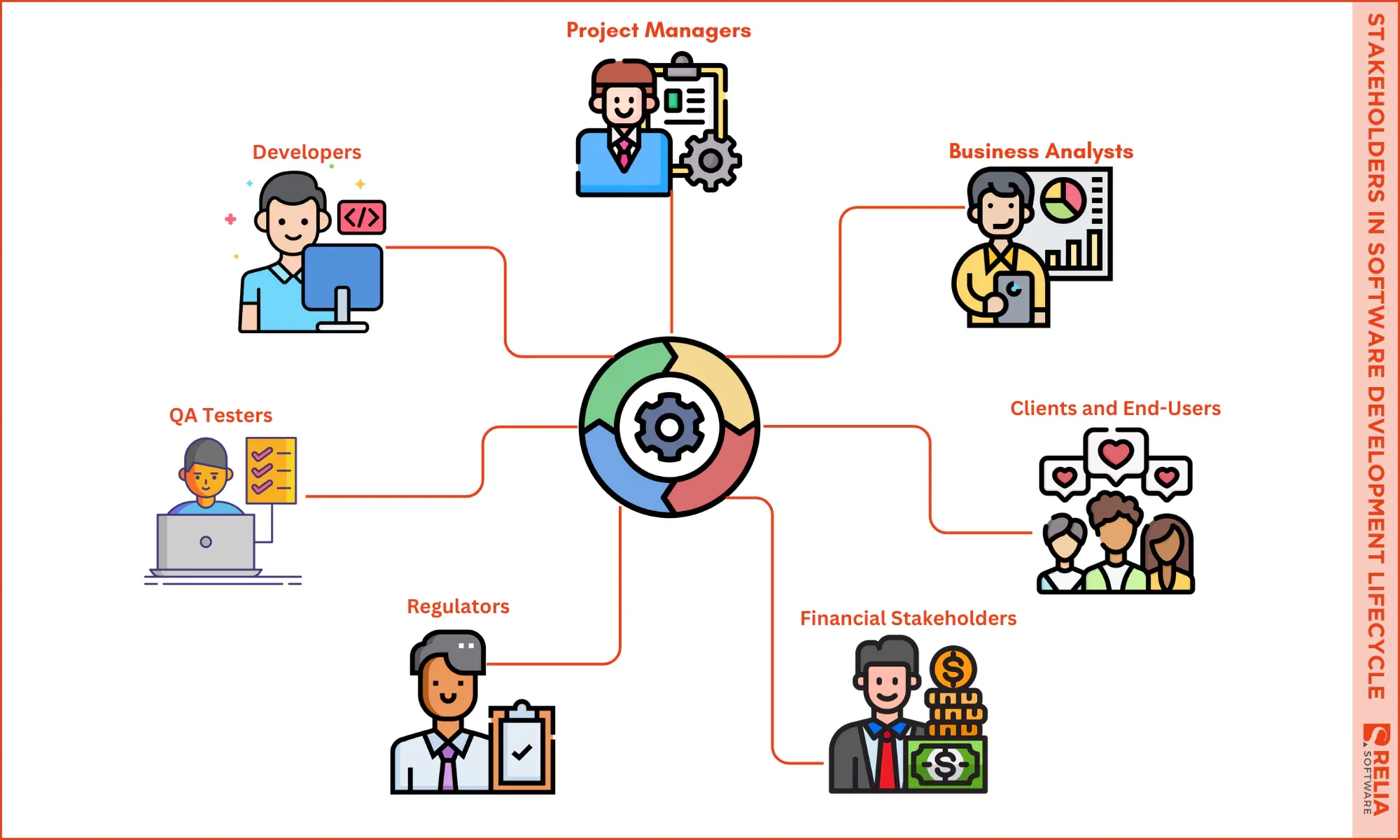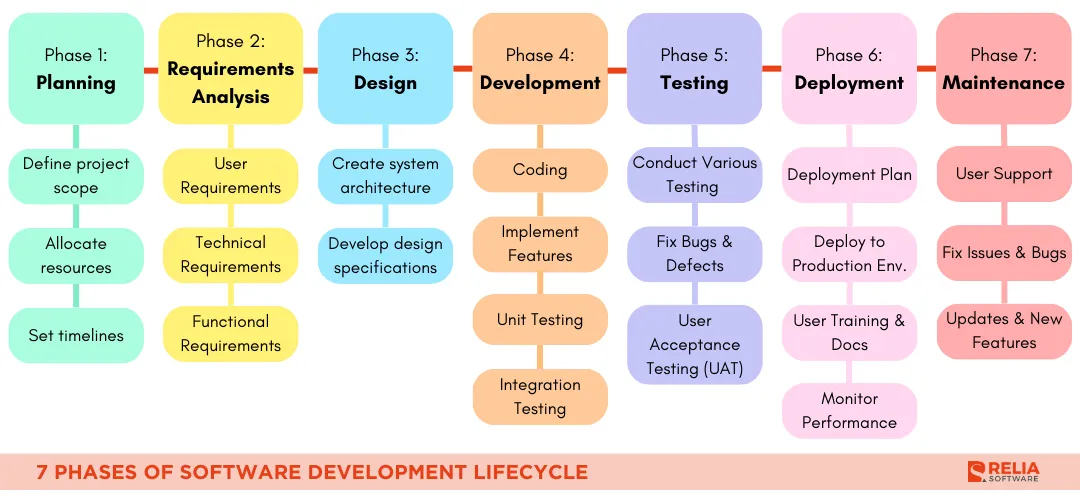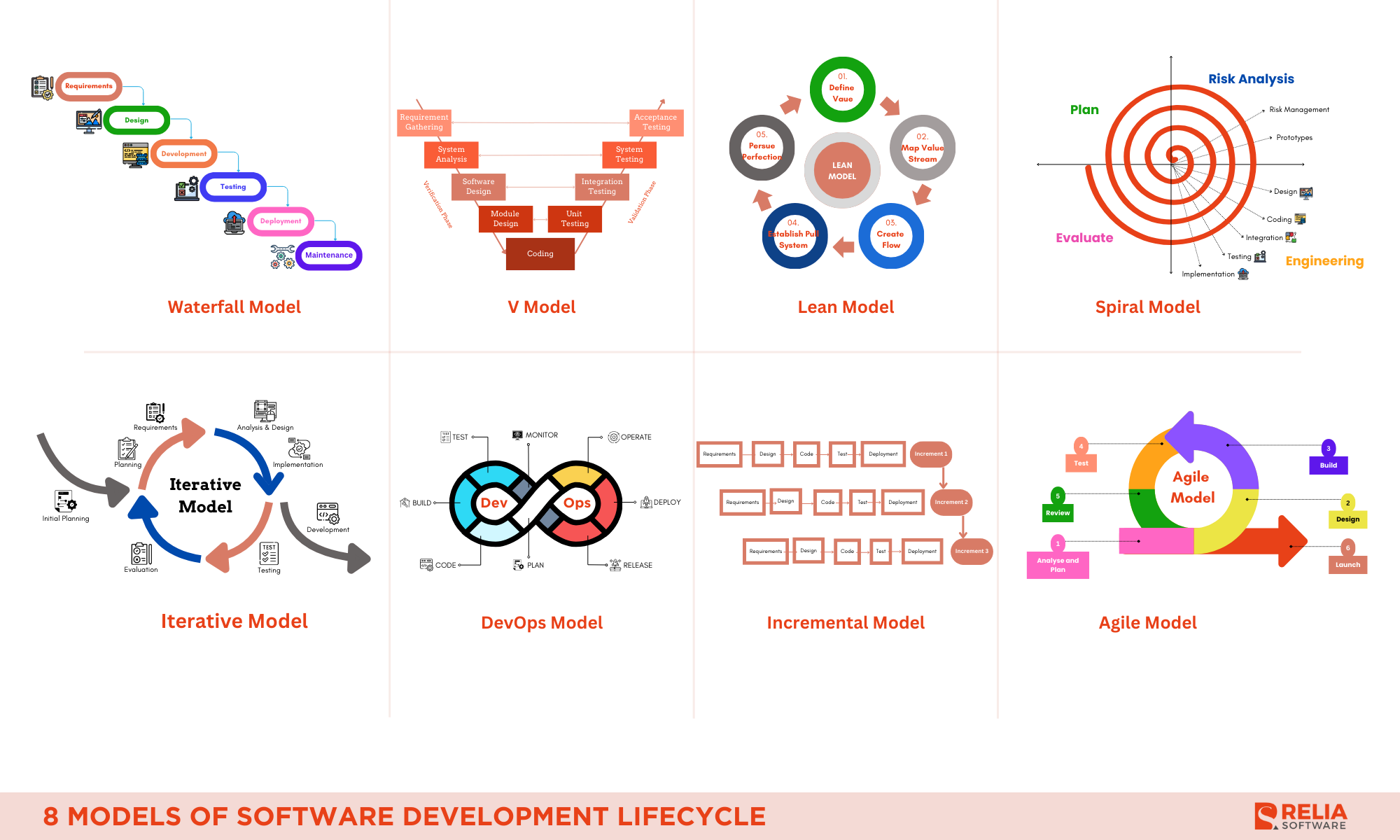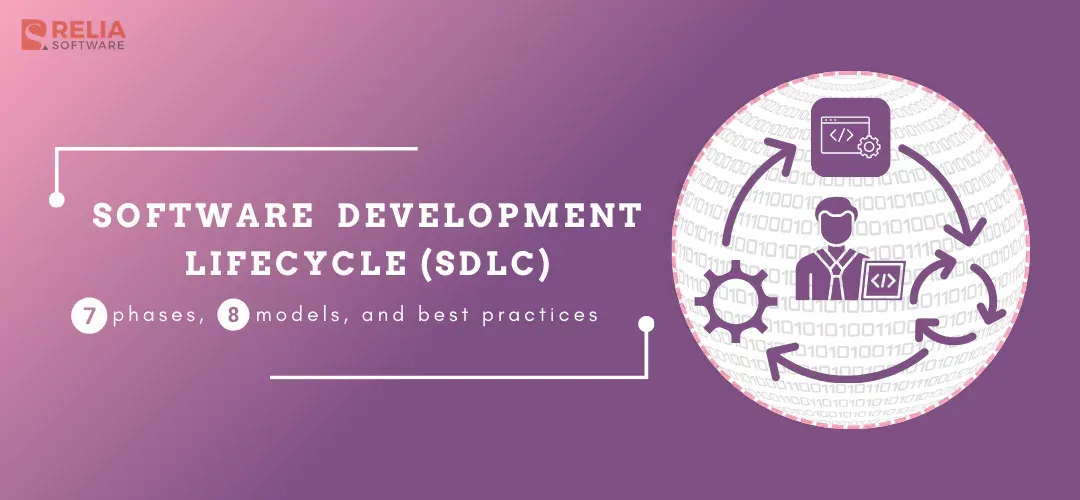An effective software development process is very important to result in a high-quality software product. Luckily, the Software Development Life Cycle (SDLC) offers a clear framework to guide this process and you'll have better results. In this blog, I'll explain the key phases, models, and best practices of SDLC, so you can see how important it is in modern software development.
What Does SDLC Stand For?
SDLC stands for Software Development Life Cycle which is a structured procedure for building high-quality software. It breaks development into clear phases like planning, building, testing, and maintaining. This framework helps developers and stakeholders stay on track and have a clear path to follow, so the development process is more efficient and smoother.
The Role of Stakeholders in SDLC
The Software Development Life Cycle (SDLC) depends critically on stakeholders who ensure the success of the project by their knowledge and points of view. These are important SDLC stakeholders with corresponding responsibilties:
Project Managers:
- Oversee the entire development process.
- Ensure tasks are completed on time and within budget.
- Manage resources, track progress, and communicate with all stakeholders.
Business Analysts:
- Bridge the gap between business needs and technical development.
- Gather requirements, analyze data, and ensure the final product aligns with business objectives.
Developers:
These are the backbone of the project, they:
- Build, test, and deploy the software.
- Work closely with other stakeholders to understand requirements and translate them into working code.
QA Testers:
- Identify and report bugs and defects throughout the development process.
- Ensure the software functions as intended and meets quality standards.
Clients and End-Users:
- Provide requirements and feedback to ensure the software meets their needs.
- Participate in user acceptance testing to validate functionality.
Regulatory and Compliance Officers:
- Ensure the software adheres to industry standards and regulations.
- Mitigate legal and compliance risks associated with the software.
Financial Stakeholders/Investors:
- Provide funding and resources for the project.
- Monitor financial performance and ensure return on investment.

7 Phases of Software Development Lifecycle (SDLC)
The Software Development Life Cycle carefully leads software projects from conception to deployment and support. Every stage together produces high-quality, efficient software that meets stakeholder needs. Here are 7 essential phases:
Phase 1: Planning
- Objective: Establish a clear roadmap by defining project goals, assessing feasibility, and setting success metrics.
- Activities:
- Define Scope: Outline the project's boundaries and functionalities.
- Allocate Resources: Choose team members, tools, and technologies.
- Set Timeline: Create a reasonable project timetable including milestones.
- Identify Risk: Determine risk by foreseeing possible difficulties and designing answers.
- Outcome: A comprehensive project plan covering the whole development process.
Phase 2: Requirements Analysis
- Objective: Understanding what the software needs to succeed.
- Activities:
- Gather user expectations and requirements via workshops, questionnaires, and interviews.
- Analyze the data to define essential features, functionalities, and user stories.
- Outcome: Clear requirements and extensive documentation that can turn user needs into features in the next phase.
Phase 3: Design
- Objective: Develop the software's architectural foundation.
- Activities:
- High-Level Design: Draw a system blueprint with important components and their interactions.
- Technology Selection: Choose programming languages, frameworks, and tools.
- System Component Definition: Specify the individual components of the system.
- Outcome: Clear development roadmaps with detailed design documents, data models, and interface designs.
Phase 4: Development
- Objective: Create a functional software product out of the design specifications.
- Activities:
- Coding: Developers write high-quality, maintainable code by following design documentation and coding standards.
- Unit Testing: Developers test individual code units to guarantee they operate as expected.
- Component Integration: Integrate individual components to create a coherent software system.
- Outcome: A fully created software ready for thorough testing.
Phase 5: Testing
- Objective: Find and fix bugs and defects before the software is deployed.
- Activities:
- Testing Types: The software undergoes various tests to uncover any issues:
- Functional Testing: Guarantees features function according to requirements.
- Non-Functional Testing: Assesses security, usability, and performance among other things.
- Regression Testing: Ensures bug fixes haven't caused new problems.
- Testing Methodologies: Different methodologies (Black-box, White-box) are employed to comprehensively test the software from various perspectives.
- Testing Types: The software undergoes various tests to uncover any issues:
- Outcome: A stable, high-quality product that meets user requirements and performs flawlessly.
>> Read more about software testing:
- How to Write A Powerful Test Plan in Software Testing?
- An Ultimate Guide to Different Test Case Design Techniques
- Detailed Explanation of 7 Software Testing Principles
- 4 Levels Of Testing In Software Testing: Explanation & Examples
Phase 6: Deployment
- Objective: Release the software into the production setting where end users will find use for it.
- Activities:
- Deployment Planning: Plan clearly how you will deploy the product, including routes of user support and training.
- Final Testing: Perform final testing in the production environment to ensure smooth operation.
- User Acceptance Testing (UAT): Involve real users to test the software and provide feedback before final release.
- Outcome: Ready-to-use software with expected functions.
>> Read more about software deployment:
- 6 Deployment Strategies for Smooth Software Updates
- Top 9 Best DevOps Deployment Tools for Businesses
Phase 7: Maintenance and Continuous Feedback
- Objective: Support users continuously, get feedback, and then implement updates to make the software better.
- Activities:
- Ongoing Support: Provide users with continuous technical help to handle issues and troubleshoot concerns.
- Updates and Enhancements: Track feedback from users and system performance, then implement bug fixes, updates, and new feature additions depending on user needs.
- Outcome: A software product that develops to stay reliable, relevant, and meets user needs. This continuous improvement keeps the software valuable over time.
>> Read more: The Importance Of Software Maintenance
Following these seven stages will help companies to use the SDLC's power to produce outstanding software.

8 Popular Software Development Life Cycle (SDLC) Models
SDLC is powerful, yet a single, strict method may not work for every project. Different SDLC models have different strengths and applications.
SDLC Models are briefly described below; check our blog for more!
Waterfall Model
- Description: A linear and sequential approach where each phase must be completed before the next begins.
- Use Cases: Suitable for projects with well-defined requirements.
- Advantages: Simple to understand and manage.
- Disadvantages: Inflexible to changes during development.
V-Model
- Description: An extension of the Waterfall model with a focus on validation and verification.
- Use Cases: Best for projects requiring high reliability.
- Advantages: Early test planning, clear and systematic.
- Disadvantages: Strict like Waterfall, but less flexible to changes.
Agile Model
- Description: Short, iterative development cycles are the main focus of agile. It divides requirements into smaller user stories that are continuously developed, tested, and delivered.
- Use Cases: Perfect for projects whose needs change over time.
- Advantages: Adaptable to changes, promotes continuous improvement.
- Disadvantages: Requires highly qualified teams and a high level of client participation.
>> You may consider: Top 10 Agile Frameworks In Software Engineering
Lean Model
- Description: Emphasizes customer value and waste reduction. Lean focuses on developing only what's needed, short development cycles, and fast feedback loops.
- Use Cases: Projects requiring efficiency and quickness.
- Advantages: Reduces waste, improves efficiency.
- Disadvantages: Hard to adopt in large companies.
Iterative Model
- Description: Focuses on continuous improvement over repeated cycles. This model combines Waterfall and Agile.
- Use Cases: Best for large projects with unclear needs.
- Advantages: Early detection of issues, improved risk management.
- Disadvantages: Requires more resources and time.
>> Read more: In-depth Explanation Of Iterative and Incremental Development
Incremental Model
- Description: The Incremental Model, like the Iterative Model above, aims to produce functional software with features that are incrementally added in every iteration.
- Use Cases: Suitable for projects that need early partial releases.
- Advantages: Lowers the risk of the total project failure and lets software be partially deployed.
- Disadvantages: Can lead to integration issues.
Spiral Model
- Description: Combines iterative development with risk assessment, represented as a spiral.
- Use Cases: Suitable for complex and high-risk projects.
- Advantages: Strong risk management and extensive documentation.
- Disadvantages: Can be costly and complex to manage.
>> Read more: Spiral Model vs Waterfall Model: Which Approach to Choose?
DevOps Model
- Description: Integrates development and operations to enhance collaboration and automate workflows.
- Use Cases: Ideal for projects requiring rapid delivery and continuous updates.
- Advantages: Improves collaboration, speeds up delivery, enhances reliability.
- Disadvantages: Requires cultural change and investment in automation tools.
Summary: Each model deals with software development differently, depending on project needs and business goals. Your decision may be influenced by the project's size, complexity, and degree of flexibility.
>> You may interest: 8 Popular Types of Engagement Models in Software Development

Benefits of Software Development Life Cycle (SDLC) Implementation
Better Project Management
For planning, monitoring, and managing software projects, SDLC provides a structured method. This method sets reasonable expectations, efficiently allocates resources, and manages risks throughout the project.
Enhanced Quality Assurance
The SDLC integrates testing and quality checks at each stage to help identify and address issues early. This lowers the possibility of delivering faulty software, guaranteeing a reliable high-quality end product.
Cost and Time Efficiency
SDLC cuts costs and delays by accurately assessing and allocating resources. Structured method lowers unanticipated risks, optimizing time management and development cost.
Increased Collaboration and Communication
The SDLC encourages cooperation and communication between clients, business analysts, developers, and testers. You are aware that increased understanding, transparency, and expectation alignment are necessary for successful project outcomes.
Best Practices in Software Development Life Cycle (SDLC)
Comprehensive Documentation
Maintain detailed documentation at each phase of the SDLC to ensure clarity and consistency. This includes requirements, design specifications, testing plans, and user manuals. Comprehensive documentation aids in knowledge transfer and provides a reference for future maintenance and updates.
Version Control and Code Management
Using version control systems, like Git, you can manage source code changes, track updates, interact with team members, and revert to earlier versions as needed. To ensure code quality and structure, apply code management strategies such as modularization, code reuse, and consistent naming standards.
Continuous Integration and Deployment (CI/CD)
Implement CI/CD practices to automate the build, testing, and deployment processes. Regularly integrate changes, run automated tests, and deploy the software to staging or production environments to enhance efficiency and reduce errors.
Code Reviews
Regular code reviews find problems and help to preserve quality. Peer review is another way I suggest for team members to exchange expertise, provide comments, and improve code maintainability and readability. To get decent coding standards, code reviews must be valued in the process.
>> Read more: Top 10 Automated Code Review Tools For Developers
Automated Testing
Software quality is ensured by automated testing. You can use unit testing frameworks to create automatically running test cases. Run integration, functional, and performance testing as well to identify and address issues early in the development cycle.
Collaboration and Communication
Always boost collaboration and communication of development team and stakeholders. To keep everyone informed, aligned, and engaged in the development, use project management tools, communication platforms, and regular meetings. Encourage openness and feedback to improve teamwork and project results.
Security Best Practices
Incorporate security measures from the beginning of the SDLC to protect against vulnerabilities. I recommend some key things like applying safe coding techniques, scheduling frequent security audits, and following compliance guidelines. Giving security a top priority during development lowers risks and protects data integrity.
Post-Deployment Monitoring and Maintenance
Monitoring the software after deployment helps find and fix issues rapidly. Software should be updated often to meet changing needs and improve performance. Besides, your software product stays reliable and relevant with regular maintenance.
By integrating these best practices, organizations can develop high-quality software that meets user expectations, maintains robust development workflows, and adapts to evolving needs.
Conclusion
The Software Development Life Cycle (SDLC) is absolutely helping businesses navigate the software development process. With 7 phases, 8 models, and best practices, the SDLC guarantees the development of high-quality software solutions.
From requirements collecting to deployment and maintenance, SDLC provides the necessary organization and control for successful software development projects. Using SDLC techniques enables businesses to offer dependable, reasonably priced, timely, customer-centric software solutions.
>>> Follow and Contact Relia Software for more information!
- development

